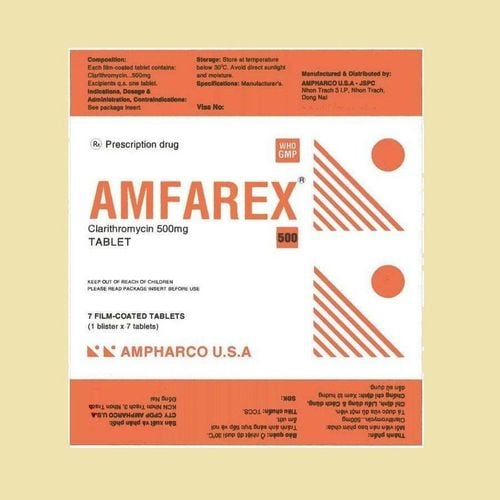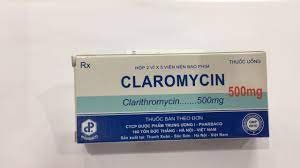This is an automatically translated article.
Cagenine medicine contains the main ingredient is Clarithromycin 500mg. The drug is used to treat tonsillitis, acute sinusitis, otitis media, chronic bronchitis with exacerbations, skin and soft tissue infections, pneumonia, whooping cough, diphtheria and peptic ulcers,...
1. What is Cagenine?
Cagenine belongs to the group of antiparasitic, anti-infective, antiviral and antifungal drugs. Cagenine is prepared in the form of film-coated tablets, packaged in boxes of 1 blister x 10 film-coated tablets of 500mg.Cagenine drug has the main ingredient is Clarithromycin 500mg and other excipients such as: tapioca starch, lactose, talc, magnesium stearate, hydroxy propyl methyl cellulose, PEG 6000, titanium dioxide.
2. What does Cagenine do?
Cagenine is used in the following cases:
Tonsillitis, chronic bronchitis with exacerbations, otitis media and acute sinusitis. Infections of the skin and subcutaneous soft tissues caused by susceptible bacteria. Pneumonia caused by Mycoplasma pneumoniae and Legionella, early stage of pertussis , diphtheria . Combination for eradication of Helicobacter pylori bacteria in peptic ulcer. Opportunistic infections (Mycobacterium avium complex) in HIV-infected patients.
3. Dosage and how to take Cagenine
Cagenine is prescribed by a doctor, patients need to strictly follow the instructions for taking the prescribed medicine.
Reference dosage of Cagenine is as follows:
Adults: The usual dose is 250mg of Clarithromycin x 2 times for 7 days, or 500mg of Clarithromycin modified release x 1 time/day. In severe infections, the dose may be increased to 500 mg Clarithromycin twice daily or 1000 mg Clarithromycin modified-release once daily for up to 14 days. Children over 12 years: Use Clarithromycin as adults. Children under 12 years of age: Using Cagenine emulsion for pediatric patients: The daily dose for children is 7.5mg Clarithromycin/kg, 2 times a day to a maximum dose of 500mg Clarithromycin. The duration of treatment with Cagenine is usually 7-10 days depending on the strain causing the disease and the severity of the disease. Treatment of strep throat requires taking Cagenine for at least 10 days. The prepared suspension can be taken with or without a meal and taken with milk. Eradicating H. pylori in duodenal ulcer patients:
Adults: The usual dose is 500mg of Clarithromycin twice daily for 7 days. Cagenine should be used with omeprazole 40 mg orally twice daily. Elderly: Use clarithromycin as adults. Renal Impairment: There is usually no need to adjust the dose of Clarithromycin unless the patient has severe renal impairment (creatinine clearance less than 30ml/min). If dose adjustment of Clarithromycin is required, the total daily dose should be reduced by half, eg 250 mg of Clarithromycin once daily or 250 mg of Clarithromycin twice daily in severe cases.
4. Contraindications to taking Cagenine
Cagenine drug is not used in the following cases:
Patients with a history of increased hypersensitivity to antibiotics of the Macrolide group. Do not use with ergot derivatives. Do not use with any of the following drugs: Cisaprid, Terfenadine and Pimozide. Increased concentrations of cisapide, terfenadine, and pimozide have been reported in patients receiving both these drugs and clarithromycin. This can cause QT prolongation and arrhythmias including ventricular tachycardia, torsades de pointes, and ventricular fibrillation. Similar effects have been observed with concomitant administration of Astemizole and other macrolides. Pregnancy and lactation as the safety of Clarithromycin during pregnancy and breastfeeding has not been established. Therefore, Cagenine should not be used during pregnancy or lactation unless the benefits outweigh the risks. Several animal studies of Cagenine have suggested embryotoxic effects, but only at doses with obvious maternal toxicity. Clarithromycin was not detected in the milk of lactating animals and in breast milk. Patients with ischemic heart disease or electrolyte imbalance.
5. Cagenine drug interactions
The following are some of the reported Cagenine drug interactions:
The active ingredient Clarithromycin in Cagenine has not been shown to interact with oral contraceptives. Concomitant administration of clarithromycin and oral administration of drugs metabolized by the cytochrome P450 system such as Warfarin, ergot alkaloids, Triazolam, Disopyramide, Lovastatin, Phenytoin and Cyclosporin may increase serum concentrations of these drugs. Administration of clarithromycin to patients receiving theophylline increases serum theophylline concentrations and the potential toxicity of theophylline. The effectiveness of Digoxin may be increased by concomitant administration of Cagenine and Klacid. Serum digoxin levels should be monitored regularly. Cagenine may increase the potency of Carbamazepine by decreasing the rate of excretion. Macrolides have been reported to alter the metabolism of Terfenadine, causing increased concentrations of Terfenadine. This condition is accompanied by cardiac arrhythmias. Clarithromycin should therefore be avoided in patients taking terfenadine and any related non-sedating antihistamines such as astemizole. Concomitant administration of clarithromycin with zidovudine to HIV-infected patients may decrease steady-state zidovudine concentrations. The decrease in zidovudine concentrations can be largely avoided by arranging doses of Klacid and zidovudine approximately 1-2 hours apart. No similar reduction in zidovudine concentrations has been observed in children. Although plasma concentrations of clarithromycin and omeprazole may be increased when given concurrently, no dose adjustment of clarithromycin is required. Increased plasma concentrations of Clarithromycin may also occur when Clarithromycin is co-administered with Maalox or Ranitidine and no dosage adjustment of Clarithromycin is required. To avoid interactions, before being prescribed Cagenine, patients should inform their doctors about all the drugs they are using, including functional foods. The doctor will base on that to prescribe the appropriate Cagenine.
6. Side effects when taking Cagenine
In general, Cagenine is well tolerated. However, in the process of using Cagenine, patients may experience some side effects such as:
Nausea and vomiting, indigestion, diarrhea with abdominal pain. Gingivitis and oral granulomatous and stomatitis. Headache. Allergic reactions such as: Urticaria, mild skin rash, anaphylaxis, rare Stevens-Johnson syndrome). Taste disorder. Loss of color in the tongue. Central Nervous System: Anxiety, hallucinations, dizziness, insomnia, psychosis, nightmares and confusion. Hearing loss is usually reversible upon discontinuation of Cagenine. Pseudomembranous colitis is rare with clarithromycin and can range from mild to life-threatening. Hepatic dysfunction includes altered liver function tests, hepatitis, and biliary tract infections with or without associated jaundice. Severe liver dysfunction and potentially fatal liver failure have been reported very rarely. If you experience these symptoms, the patient should stop using Cagenine and notify the doctor for appropriate treatment.
7. Precautions when using Cagenine
Cagenine is excreted mainly by the liver and kidneys. Should be used with caution in patients with impaired liver or kidney function. Prolonged and repeated use of Cagenine may cause the growth of fungi or bacteria that are no longer susceptible to the drug. If superinfection occurs, Cagenine should be discontinued and appropriate therapy instituted. In some patients, H. pylori bacteria can become resistant to clarithromycin. The use of clarithromycin in patients concomitantly with drugs metabolized by the cytochrome P450 system may increase serum concentrations of drugs metabolized by the cytochrome P450 system. Above is all information about Cagenine, patients need to carefully read the instructions for use, consult a doctor / pharmacist before using. Note, Cagenine is a prescription drug, patients need to use the drug as prescribed by the doctor, absolutely do not self-treat at home.













